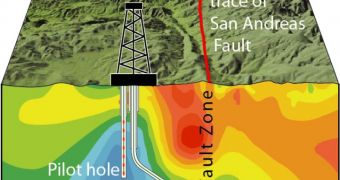One of the most ambitious tectonic research projects is currently nearing completion on the western coast of the United States. Its purpose is to drill a very deep hole straight into the San Andreas fault line, and install scientific measuring equipment within.
The initiative belongs to the National Science Foundation (NSF) and the US Geological Survey (USGS). They decided to conduct this large-scale experiment because the area affected by this particular fault line is extensive and heavily populated.
The organizations collaborated before, on the Parkfield Earthquake Experiment. This endeavor went on for more than 15 years, and allowed scientists to accumulate sufficient know-how to take on a project as ambitious as the San Andreas Fault Observatory at Depth (SAFOD).
All measuring equipment will be inserted near an area that has over the past few years yielded numerous magnitude 6 earthquakes. At the end, the instruments will be located between 2 and 3 kilometers (1.2 and 1.8 miles) beneath the planet's surface.
One of the most important goals in the new study is to analyze the chemical and physical processes that control the way earthquakes are generated. SAFOD will also differ from any other observatory of this kind through the fact that it will monitor a geologically-active fault line in real-time.
The USGS and the NSF collaborated closely with the petroleum industry for this project. This allowed them to acquire advanced directional drilling technologies, which enable them to create a network of tunnels branching out from the main borehole.
At the same time, other instruments will enable the collection of rocks and fluids from the fault line zone itself. Analyzing these rocks could reveal important clues about what goes on before, during and after earthquakes are triggered in a fault line.
“SAFOD's long-term monitoring activities will include detailed seismological observations of small to moderate earthquakes and continuous measurements of rock deformation and other parameters during the earthquake cycle,” a press release from the USGS explains.
“SAFOD will provide direct information on the composition and mechanical properties of rocks in the fault zone, the nature of stresses responsible for earthquakes, the role of fluids in controlling faulting and earthquake recurrence, and the physics of earthquake initiation and rupture,” the statement adds.
Together with other similar project, SAFOD is a part of the US National Earthquake Hazard Reduction Program, whose main purpose is to safeguard the lives and property of people living on or around geologically-dangerous areas.

 14 DAY TRIAL //
14 DAY TRIAL //